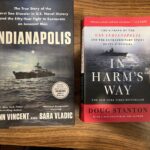At 12:05 am on Monday, July 30, 1945, a torpedo fired from a Japanese submarine struck the starboard side of the USS Indianapolis, near the bow; seconds later a second torpedo hit her amidship, also on the starboard side. Minutes later, the cruiser, on a run from Guam to Leyte on the last days of the war, disappeared beneath the waves. Approximately 300 men died aboard ship, the lucky ones killed immediately, even vaporized by explosions, others by drowning and many in the most horrible way: by burning. Approximately 900 men, including the commanding officer, Captain George Butler McVay, 111, made it off the ship. They were in the water for three days before anyone knew the ship had been sunk. By the fourth day, when they were rescued at last only 315 men had survived. Many had been killed by sharks whose presence was relentless, attacking at dawn and sunset. The sinking of the Indianapolis is deemed to be the worst disaster in U.S. naval history.
It would be a spoiler to tell you of the mistakes the navy brass made that increased the chances that the Indianapolis would be attacked and undeniably was the only reason the survivors were in the water as long as they were. And yet Captain McVay was the officer court martialed. Both books tell of the survivors’ long struggle to exonerate their captain. Having served in much less dangerous times at sea and later on land, I am not surprised by this injustice, but I am outraged.

Both books, In Harm’s Way, by Doug Stanton, and Indianapolis, co-authored by Lynn Vincent and Sara Vladic, are compelling reads, with driving narrative force, specificity of detail and deep penetration into the suffering and valor of the crew via the authors’ interviews with the survivors. I read Indianapolis two years ago and was so haunted by the tragedy that when I discovered In Harm’s Way recently, I read voraciously. The books are not redundant of each other. They complement each other. They address the tragedy from different perspectives and tell the events in different sequences. At their essence they both are a cry for peace on earth.

Leave A Comment